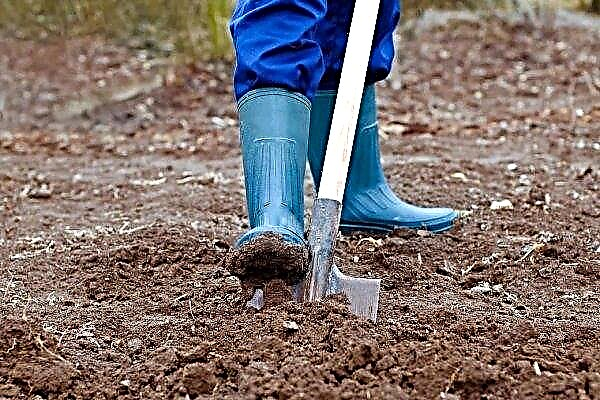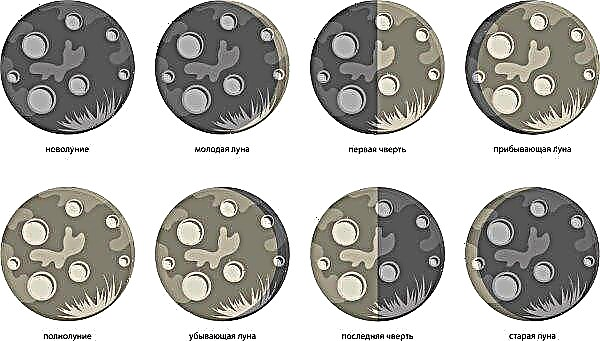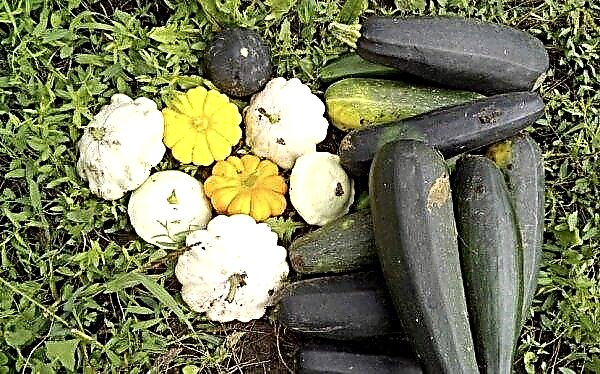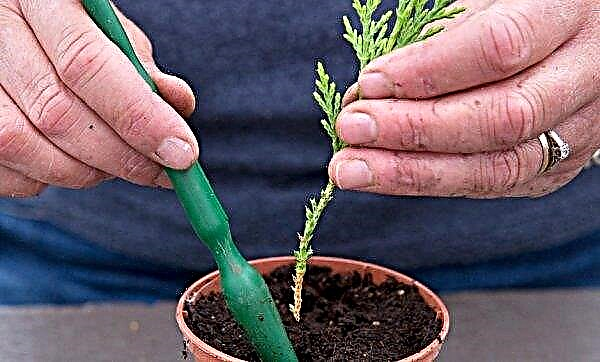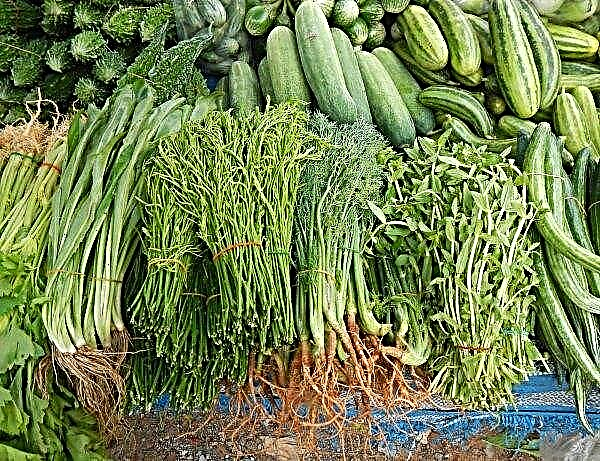It is simply impossible to do without a properly designed greenhouse in a summer residence business, therefore it is not surprising that the corresponding structure can be found in almost any area. In this article, we will talk about a greenhouse called "Country House" from the Volia company, and what exactly it is remarkable for, and how to assemble the structure correctly, you will learn from this article.
Features of the greenhouse "Summer cottage"
The main feature of this design lies in its narrow and elongated shape, which is explained by the relatively small width of the shelter: no more than 2 m as standard. The compact size allows you to install a greenhouse even in areas with limited space. Its height is 2.2 m, but the length depends on personal preferences and can be adjusted with additional inserts, with basic indicators of 2 m. Of course, this is not the only advantage, and the disadvantages of the design can not be ignored, which means that you should pay attention to the purchase to study all the pros and cons of a particular shelter.
Benefits
- The main strengths of the “Summer cottage” include:
- reinforced frame and increased strength;
- sufficient capacity (with a relatively small size of the shelter, it is perfect for a variety of work inside);
- optimal height, which provides the ability to grow both undersized and tall crops;
- quick warming up of the internal space and long-term heat preservation due to the polycarbonate coating;
- the possibility of increasing the length of the greenhouse;
- transportability and ease of installation;
- possibility of installation without foundation organization (galvanized profile prevents damage to the frame from moisture);
- compactness.
Did you know? The largest greenhouse in the world is considered a building called "Eden", located in the city of Cornwall, in the UK. This is a whole complex of interconnected dome-shaped shelters, which in total occupy 0.654 ha and reach a height of 35 m, with a width of 65 m and a length of 135 m.
Disadvantages
- Like any other construction, the “Summer cottage” is not without certain drawbacks and, first of all, this list includes the following features of the greenhouse:
- insufficient space for growing a large number of crops, especially on an industrial scale;
- the possibility of cultivating the soil with only one person, since being inside two people will complicate their comfortable stay there;
- the presence of a large number of parts, which will require a certain focus on all actions, and even with the most accurate instructions;
- the need for help of another person during the assembly (it will not work out independently);
- the problematic use in too windy areas, especially without a solid foundation (due to the elongated shape and the presence of a relatively light polycarbonate coating, sail is possible).
 If you correctly approach the issue of choosing a site for the greenhouse and its reliable fixation during assembly, then some of the shortcomings will not be so relevant, but as for the limited space for growing plants, it is really better to choose a larger greenhouse for mass plantings
If you correctly approach the issue of choosing a site for the greenhouse and its reliable fixation during assembly, then some of the shortcomings will not be so relevant, but as for the limited space for growing plants, it is really better to choose a larger greenhouse for mass plantingsSelection of drawings and optimal greenhouse sizes
The basic package of the “Summer cottage” greenhouse includes:
- a pair of doors and a pair of window leaves;
- vertical and horizontal design amplifiers;
- T-shaped frame legs;
- longitudinal runs;
- 2 doorways;
- wireframe arcs.
The face seal is not provided in the kit and will have to be ordered separately, like polycarbonate sheets.
Did you know? The largest number of greenhouses is located in the Netherlands, and local gardeners traditionally cover structures with glass, not polycarbonate. The total area of greenhouses in the Netherlands is 10,500 ha.
As for the standard technical characteristics of the finished greenhouse, the main ones will be:
- height - 2.2 m;
- width - 2.0 m;
- length - from 2 m (but may increase to 4 m or more);
- the distance between the frame arcs is 1 m;
- minimum weight - 30 kg;
- maximum snow load - 240 kg per 1 m².
 If you grow plants for your own consumption, while having a small plot, then "Country Cottage" is exactly what you need. Such a shelter is quite enough for the cultivation of familiar crops in the form of tomatoes, cucumbers, peppers, root crops. If necessary, you can increase the length of the structure, thereby increasing the number of future crops.
If you grow plants for your own consumption, while having a small plot, then "Country Cottage" is exactly what you need. Such a shelter is quite enough for the cultivation of familiar crops in the form of tomatoes, cucumbers, peppers, root crops. If necessary, you can increase the length of the structure, thereby increasing the number of future crops.How to make a greenhouse "Country Dvushka" of polycarbonate with your own hands at home
If you have already dealt with the assembly of similar structures, then no problems should arise, especially since complete instructions for their installation are included with the main components. All that is required is to choose a place suitable for installation, if necessary, organize the foundation and install a frame in the intended place, on which polycarbonate sheets will be attached.
Foundation selection
When choosing a place for installing a greenhouse, make sure that the distance to the nearest buildings and trees is at least 2 m. This should not be too low or, on the contrary, too high, since the ideal option is the most even area from the south-eastern part of the site, closed from the cold northerly winds of any building.
The ends of the greenhouse shelter should go east or west, and if the personal territory is located in the closest proximity to the road, then it is better to move it away from the fence so that the dust does not eat into the polycarbonate coating. Consider also the possibility of expanding the greenhouse in the future, so at least several meters of free space should remain along the length. The presence of a foundation for the described structure is not a prerequisite for its installation, therefore, if soil shifts are excluded and the site is located on the most even surface, then you can do with only T-shaped ends on the racks, with which the support is fixed in the ground. In inclined areas, especially if year-round plant cultivation is planned, such a solution will not work and you will have to think about a more reliable foundation.
The presence of a foundation for the described structure is not a prerequisite for its installation, therefore, if soil shifts are excluded and the site is located on the most even surface, then you can do with only T-shaped ends on the racks, with which the support is fixed in the ground. In inclined areas, especially if year-round plant cultivation is planned, such a solution will not work and you will have to think about a more reliable foundation.
There are several possible options in this question:
- make a foundation of wooden blocks;
- use artificial products like bricks and blocks for its arrangement;
- pour in a shallow strip foundation.
The last solution is appropriate for the construction of a stationary greenhouse shelter, but before pouring concrete, once again consider all the pros and cons of such a foundation:
- it reliably protects the root system of plants from return frosts, insect pests and heat loss;
- prevents possible tipping and deformation of the shelter surface;
- increase the height of the structure, thereby increasing the size of the usable space;
- you can no longer move the greenhouse to another place;
- assembly of the structure will require much more time and the presence of an assistant;
- the cost of purchasing materials will increase, which means that the finished construction will pay off a little longer.

If, having compared all the pros and cons, you still decided in favor of the popular concrete base, then it is worth doing the following:
- Clear the selected territory and mark it according to the parameters of the acquired greenhouse.
- Organize a trench, the depth of which will be 30 cm, and the width will reach 15 cm (this will help the horizontal level).
- Seal the bottom of the hole and fill it with a 10-cm layer of sand, moisturizing and compacting the sand cushion.
- Install formwork, for which waterproof plywood or planed boards can be used.
- Knead a solution of a mixture of sand, cement and gravel (2: 1: 2) and fill the foundation, periodically piercing the mixture with a metal rod and tapping the formwork.
Important! It will be possible to proceed to the assembly of the frame itself not before the concrete foundation has completely dried, which may take at least 2-3 days.
Greenhouse assembly instructions
Compliance with the requirements of the assembly instructions for the “Dacha Dvushka” greenhouse guarantees a long service life of the product due to the strong connection of the individual constituent elements, therefore stock up on gloves and proceed to the following steps for connecting the purchased design:
- Open the package and lay out the entire contents of the delivery kit (each individual part has its own individual number, which greatly facilitates the installation process).
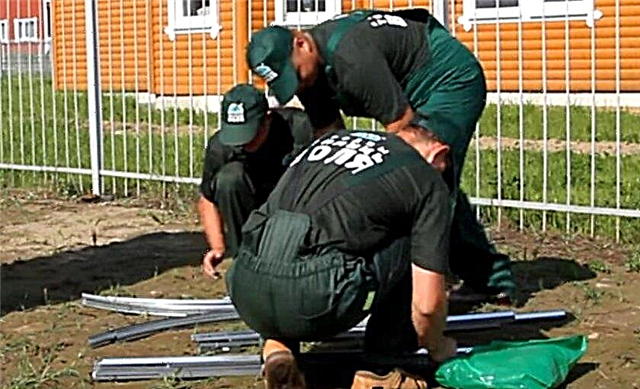
- Take the power arcs and first connect the parts 4B and 4H to get the dome of the arc. In the same way, it is worth collecting all the upper parts of these elements that are in the set.
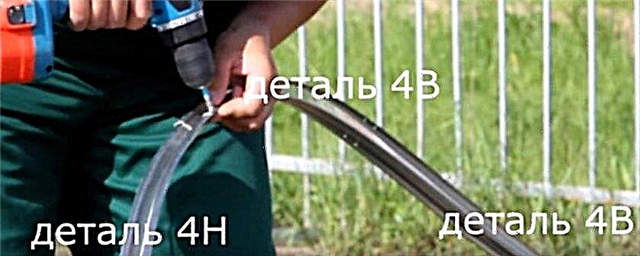
- Screw the racks to the lower parts of the connected parts. Also find the base racks and attach them to the bottom of the ordinary.

- Fix the supporting part (usually goes with number 3) to the foundation posts.
- Having received the necessary number of arcs for fastening the covering material of the greenhouse, reinforce them with horizontal ties, strut elements, radial ties and corner cuts. A horizontal screed should connect in the upper part two half-arches 4H and 4B.

- In parallel to the “wall” arc, install the struts, reinforcing them in the middle with radial ties (they connect the strut and the arc itself).

- Attach corner arcs to the brace fixing angle and horizontal tie to get fully assembled power arcs.

- In the same way (with the exception of struts and screeds), it is necessary to collect end arcs, first connecting the vertical elements of the future doorway and fixing them to the upper arcs (4VK).
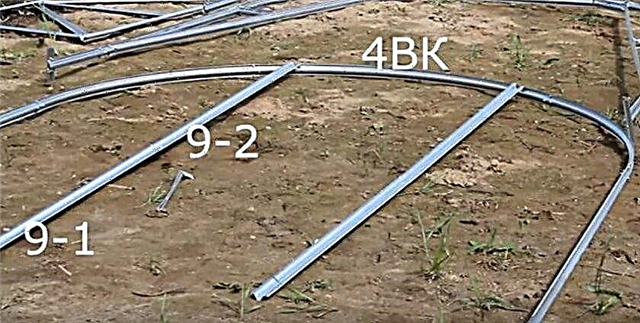
- Connect the vertical and horizontal parts of the doorway with the end connecting elements.
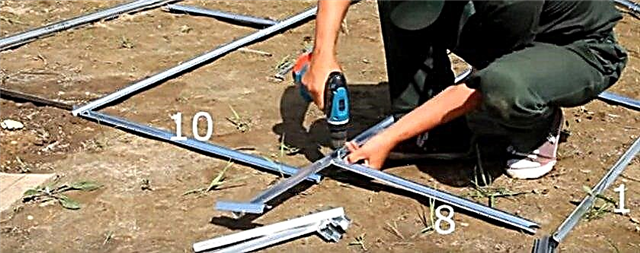
- Fasten the foundation racks, supports and end arches, fixing them in the lower part of the latter.

- Combine the end arc with the power arc, using the extreme and main runs for this.

- Fasten all power and end arcs into a single structure and connect the runs at the desired points.

- Dig a 30-centimeter trench (if the foundation is not used) and place the included T-shaped endings in it, leveling the entire structure.
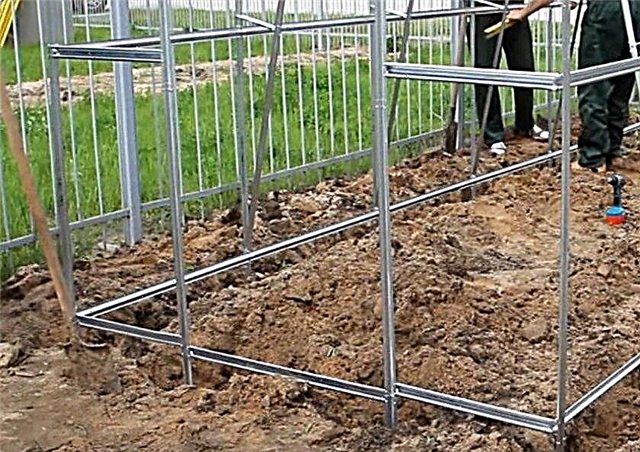
- Fill the recess, compact the soil and proceed to the collection of doors and window leaves. To do this, interconnect the vertical and horizontal elements of future doors and the diagonal parts of the end vents (12DP, 14M and 13M).

- Fasten the vertical parts of the end vents 12FL and 12FP with a diagonal of 14M.
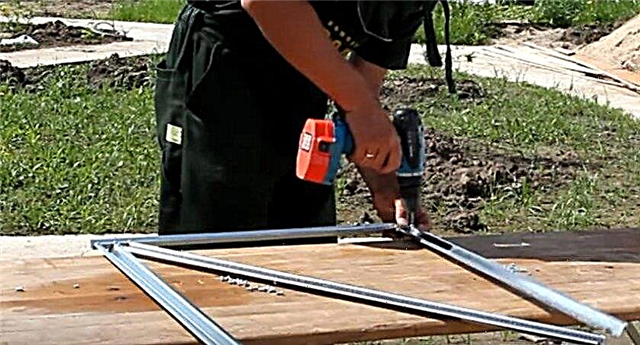
- Fix polycarbonate on the frames obtained, using clamps and washers to fix it.
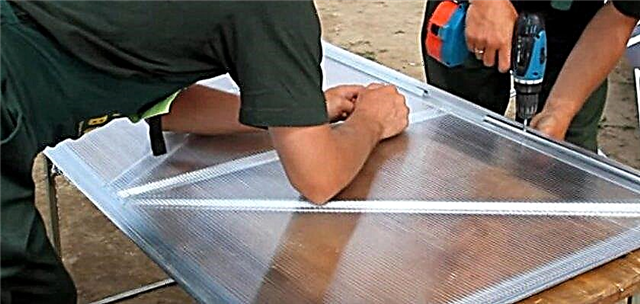
- Fix the hinge seal on the door exactly in the place where the awnings will be installed.

- Secure the door seal around the perimeter of the door.
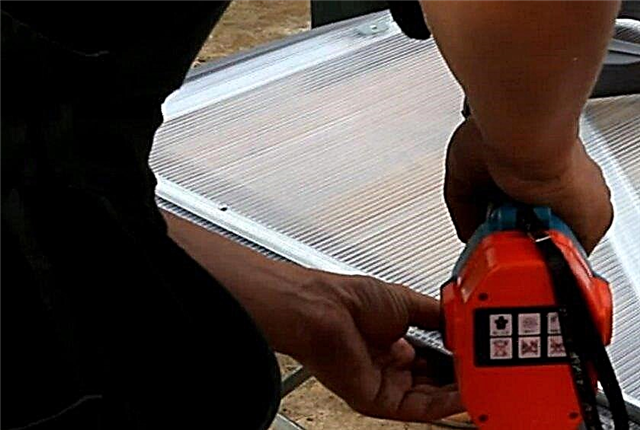
- In the same way, cover the window with covering material, fixing the diagonal (14M) over the polycarbonate coating.

- Install hinges on the door and you can safely proceed to cutting the remaining polycarbonate material for the rest of the spans of the frame structure of the greenhouse. The fastening of individual parts is carried out using the same fasteners as with the lining of windows or doors.
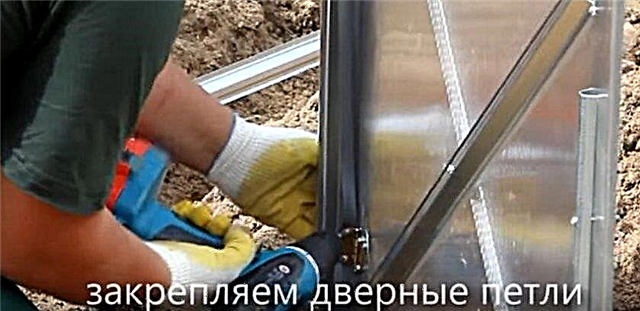
After sheathing the greenhouse with polycarbonate, it remains only to mount the end seal (where necessary) and glue the ends of the slices with adhesive tape on the material used.
Video: polycarbonate greenhouse assembly "Summer cottage"
Tips for the care and maintenance of the cottage greenhouse "Summer cottage"
In addition to the proper installation of the “Summer cottage” greenhouse, it is equally important to provide good care for the shelter so that the covering material fully fulfills its functions: transmit light from sunlight and maintain optimal temperature.
Important! The transport film from polycarbonate sheets is removed immediately before the sheet is fixed on the supports, and it must be placed upside down, protected from sunlight.
First of all, the list of basic care rules includes:
- snow removal from the surface with a large amount of winter precipitation, including from the side walls;
- regular autumn cleaning of the greenhouse, and it is better to wash off the dirt using a soap solution and clean water for rinsing (heavily soiled areas can be wiped with a sponge or dense cloth);
- When performing cleaning measures, never use abrasive and strongly acting products that can damage the surface of polycarbonate and reduce its service life;
- when disinfecting a shelter, do not use sulfur checkers, as they often lead to darkening of the surface of the frame base;
- when moving the shelter to another place, always disassemble all structural elements so as not to bend them during transportation.
 The Greenhouse "Country Dvushka" is a really good solution for most summer residents, both those who have been cultivating crops for a long time, and those who have just recently taken up gardening. Proper installation and appropriate further care for the shelter will provide full protection of the plantings and an excellent harvest of fruits.
The Greenhouse "Country Dvushka" is a really good solution for most summer residents, both those who have been cultivating crops for a long time, and those who have just recently taken up gardening. Proper installation and appropriate further care for the shelter will provide full protection of the plantings and an excellent harvest of fruits.




















